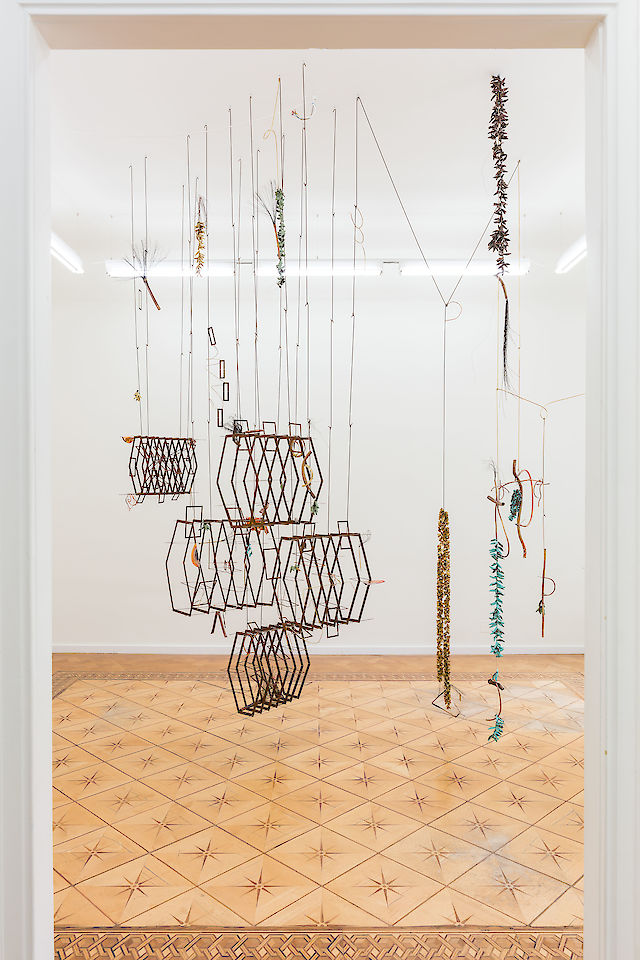Images

Iza Tarasewicz, installation view In myriads, things cry out, Croy Nielsen, Vienna, 2018

Iza Tarasewicz, installation view In myriads, things cry out, Croy Nielsen, Vienna, 2018

Iza Tarasewicz, installation view In myriads, things cry out, Croy Nielsen, Vienna, 2018

Iza Tarasewicz, installation view In myriads, things cry out, Croy Nielsen, Vienna, 2018

Iza Tarasewicz, installation view In myriads, things cry out, Croy Nielsen, Vienna, 2018

Iza Tarasewicz, installation view In myriads, things cry out, Croy Nielsen, Vienna, 2018

Iza Tarasewicz, installation view In myriads, things cry out, Croy Nielsen, Vienna, 2018

Iza Tarasewicz, installation view In myriads, things cry out, Croy Nielsen, Vienna, 2018

Iza Tarasewicz; In myriads, things cry out 4, 2018, Steel, copper, brass, 250 (height is adjustable) × 15 × 15 cm

Iza Tarasewicz; In myriads, things cry out 4, 2018 (detail) Steel, copper, brass, 250 (height is adjustable) × 15 × 15 cm

Iza Tarasewicz, In myriads, things cry out 2, 2018, Steel, copper, brass, 250 (height is adjustable) × 80 × 40 cm

Iza Tarasewicz, In myriads, things cry out 1, Steel, copper, brass, 400 (height adjustable) × 170 × 90 cm

Iza Tarasewicz, installation view In myriads things cry out, Croy Nielsen, Vienna, 2018

Iza Tarasewicz, installation view In myriads things cry out, Croy Nielsen, Vienna, 2018

Iza Tarasewicz, In myriads, things cry out 5, 2018, steel, copper, brass, 300 × 30 × 50 cm

Iza Tarasewicz, installation view In myriads, things cry out, Croy Nielsen, Vienna, 2018

Iza Tarasewicz, In myriads, things cry out 7, 2018, Steel, copper, brass, 140 × 60 × 10 cm

Iza Tarasewicz, installation view In myriads, things cry out, Croy Nielsen, Vienna, 2018

Iza Tarasewicz, In myriads, things cry out 6, 2018, Steel, copper, brass, 350 (height adjustable) × 50 × 10 cm

Iza Tarasewicz, In myriads, things cry out 6, 2018 (detail), Steel, copper, brass, 350 (height adjustable) × 50 × 10 cm

Iza Tarasewicz, In myriads, things cry out 6, 2018 (detail), Steel, copper, brass, 350 (height adjustable) × 50 × 10 cm

Iza Tarasewicz, In myriads, things cry out 8, 2018, Steel, copper, brass, 140 × 60 cm

Iza Tarasewicz, In myriads, things cry out 8, 2018, Steel, copper, brass, 140 × 60 cm
Photos by kunst-dokumentation.com
Press Release
Croy Nielsen is pleased to present the first solo exhibition of Iza Tarasewicz (b. 1981) at the gallery.
In myriads, things cry out is a set of support structures that effaces distinctions between dormancy and activity, silence and noise, harmony and dissonance, and chaos and order. The repeated hexagonal construction in the main space of the gallery supports a number of loose arrangements that together create a larger system, an organism that is more than the sum of its parts. The materials used are fundamental for Tarasewicz’ sculptural practice: structures of rusted steel, copper, and brass. The artist continuously experiments with base materials, studying their essential properties while also testing their variability and combining them so as to amplify their effects.
In myriads, things cry out lends its title from the chapter of Michel Serra’s Five Senses that deals with sound and hearing. One can consider the exhibition as a form of graphical musical notation, an abstract depiction of relationships, movements, and events. Each object implies a possible sound, and brought together, they form an ensemble that operates through an embodied logic of variations, harmonies, contrasts, tensions, releases, points, and counterpoints.
Operating more as tools than static entities, Tarasewicz’s objects and installations serve as temporary conduits for a meeting of substances. In her work, basic and humble ingredients undergo complex transformations, often through processes borrowed from craft practices and routines from daily life. Her installations often take the form of modular and reconfigurable display systems that combine a raw and modest functionalism with formal logics found in the natural world, scientific experiments, and graphs and diagrams — figures of thought and charts of relation that systematize knowledge and data and abstractly describe the interaction of phenomena. Combining these formations with simple constructions, her arrangements refer to a certain utility in abstraction.
The forms of the exhibited works are inspired from a broad history of musical instruments, which borrows materials and forms from the natural world and innovates these structures for communication, ritual, and community. But beyond the social uses of instruments, they are, at their base, direct demonstrations of physical principles and properties. Letting the nature of her materials determine the physical outcomes, Tarasewicz points to the development of tools as the co-interaction between human subjects and a set of at-hand things. Seemingly empty forms become sites for resonance, clutters of matter serve as possible concussive tools, and the size and configuration of the sculptures produce varying timbres and affects. Yet, set within a series of modular display structures, these objects lay silent and dormant, while still implying their potential activation and sonic capacities. While certainly referring to the functionality of instruments, these tools are not merely a supplement for a player to implement.
Musical performance, and technology in general, is shown as the reciprocal interaction between human and non-human actors that is generated by the interplay of materials, movements, and intensities. As John Cage suggested, we might hear through materials. But Tarasewicz’s project equally regards these tools as active agents whose physicality and structures trigger their own resonant frequencies. The things themselves speak. By combining heaps of materials into repeated arrangements and compositions, Tarasewicz accentuates the vibration of matter itself, demonstrating how myriads of particles can produce densities of information, creating a chorus of elements.
Postbrothers